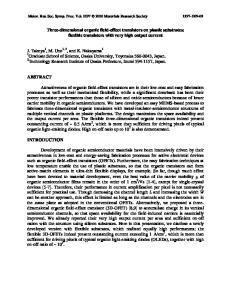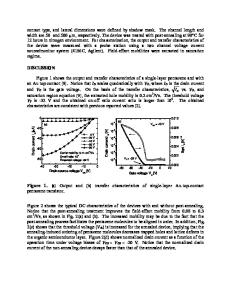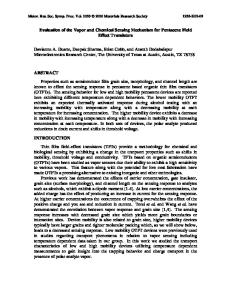High Mobility Pentacene Field Effect Transistors on Plastic
- PDF / 219,986 Bytes
- 6 Pages / 612 x 792 pts (letter) Page_size
- 47 Downloads / 363 Views
High Mobility Pentacene Field Effect Transistors on Plastic Siddharth Mohapatra1, Michelle Grigas1, Robert Wenz1, Robert Rotzolll, Viorel Olariu1, Oleg Shchekin1, Klaus Dimmler1, Ananth Dodabalapur1, 2 1
OrganicID Inc., 422 East Vermijo, Colorado Springs. Colorado
2
Microelectronic Research center, University of Texas at Austin, Austin, Texas
Correspondence should be addressed to S.M ([email protected]), K.D. ([email protected]), or A.D. ([email protected]) Abstract This paper reports the electrical properties of thin-film transistors with pentacene active layers used in a bottom contact transistor geometry utilizing solution processed poly-4-vinylphenol (PVP) as the gate dielectric processed on a polyethylene napthalate (PEN) substrate. The transistors sometimes exhibit mobilities in excess of 1cm2/Vs. The effect of various surface treatments of the gate insulator, on the electrical properties of these transistors discussed. The development of photolithographically defined 2µm channel length bottom contact transistors is emphasized as the speed of circuit elements such as the rectifier scale inversely as the square of the channel length of the transistors. Surface cleaning and semiconductor deposition techniques that improve transistor characteristics and reduce hysteresis are evaluated and the variation of the ION/IOFF ratios with the different surface treatments is noted.
Introduction Two of the greatest attractions of organic electronics include the ability to fabricate flexible circuits and systems and utilize inexpensive print-compatible processing techniques for fabrication. This necessitates the development of high performance transistors on flexible substrates. Specifically, our group is involved in developing fully printable organic RFID tags for item level tagging. To fabricate organic RFID tags, it is required that some of the sub-circuits such as the rectifiers, operate at the industry specified frequency of 13.56 MHz. To rectify such signals it is important that transistors have mobilities in excess of 0.1
H3.2.1
H3.2.2
cm2/Vsec, Ion/Ioff ratios > 100, threshold voltages ~ 0 V, low hysteresis, good saturation characteristics and good stability in air under applied bias conditions. Additionally, these properties have to be achieved on 2 -3 µm channel length transistors, as the speed of a rectifier varies inversely as the square of the channel length. Pentacene has emerged as an attractive candidate for fabricating p-channel organic thin film transistors (OTFTs)1,2,3,4. It is one of the few known p-channel organic semiconductors that regularly exhibit mobilities in excess of 1 cm2/Vsec on SiO2.5 In this article, we describe our efforts towards the development of 2µm channel length pentacene based transistors on plastic with PVP (poly-4vinylphenol) as the dielectric that have the above-mentioned characteristics. Pentacene is our initial semiconductor of choice, as it has the highest reported mobility and thus provides a good platform for modeling organic circuits. We are also evaluating po
Data Loading...











